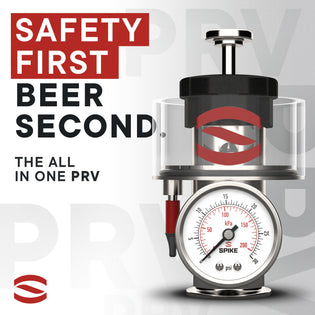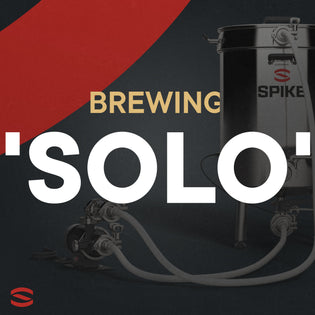By Neva Parker
Brewers yeast, Saccharomyces cerevisiae, is a unique and amazing microorganism (the same organism used in distilling and breadmaking). These organisms require sources of carbohydrates, in the form of simple sugars, to feed themselves and reproduce. When oxygen is present, yeast are able to produce large amounts of energy, which they use to replicate exponentially and increase their population. This same process, in the absence of oxygen, proceeds down a very different pathway known as fermentation.
Simply stated, fermentation in the brewing process happens when yeast convert sugars from wort (sugar water made from malted barley) and metabolize them into ethanol, carbon dioxide, and secondary flavor and aroma compounds.
Why Is Fermentation So Important?
The fermentation process is a necessary step in the creation of any alcoholic beverage, without which, we would have just plain sugar water. In beer production, yeast fermentation is especially important. Like all alcoholic beverages, the main purpose of yeast for a brewer is to produce ethanol and carbon dioxide from wort carbohydrates.
However, the secondary compounds that are produced during yeast fermentation are equally important, because they provide complex subtleties to beer, including mouthfeel, aroma, and taste.
It has been shown that yeast produce over 500 flavor and aroma compounds as secondary metabolites during fermentation, and give certain beer styles their distinct characteristics. The compounds that make up the spectrum of most beer descriptors can be generally categorized into some common groups: esters, fusel alcohols, phenols, aldehydes, diacetyl, and sulfur compounds.
Esters
Esters play a big role in the character of beer, especially in ales. An ester is a compound made up of an acid and an alcohol and it is esters that provide the fruity aromas and flavors that you find in beer.
Ester production varies by yeast strain and fermentation conditions. Some common esters are ethyl acetate (solvent), ethyl caproate (apple), and isoamyl acetate (banana).
Fusel Alcohols
Fusel, or higher, alcohols such as n-propanol, isoamyl alcohol, and isobutanol taste similar to ethanol, but they can add warming, hot, or solvent flavors and mouthfeel to beer.
While these are not desired traits at high levels in any beer style, many good-tasting beers do contain fusel alcohols at low levels where they add complexity. Yeast strains vary in fusel alcohol production, with ale strains generally producing higher fusel alcohol concentrations than lager strains.
Phenols
Phenolic compounds can come from both ingredients and fermentation. Phenolic compounds from yeast are described as spicy, clovey and in high concentrations, plastic, medicinal, Band-Aid, and smoky.
In the majority of beer styles, phenolic flavors are a flaw, although there are some obvious exceptions. Bavarian hefeweizen must have clove and some Belgian beers have other phenolic characters, all of which are derived from yeast metabolic byproducts.
Acetaldehyde
Sometimes noted as green apple or fresh cut pumpkin, acetaldehyde is a precursor compound in the fermentation process - it is an intermediate that is formed and reused to complete a metabolic cycle.
Most acetaldehyde is reused by yeast, but some can be left behind. While some level of this compound is acceptable in beer, and even adds to the complexity, excessive levels of acetaldehyde are generally referred to as an off-flavor and can be considered “green” or unfinished. Longer conditioning can often reduce levels of acetaldehyde if they are noticeable.
Diacetyl
Even though many classic beer styles allow for low levels of diacetyl and some consumers find it pleasant, many consider it a flaw in any quantity. Even at low levels, it can contribute slickness or slipperiness to a beer’s mouthfeel. In higher quantities, it gives beer a buttery or butterscotch-like aroma and flavor.
Some yeast strains, particularly highly flocculent English ale strains, are heavy diacetyl producers.
Sulfur
Sulfur compounds in beer smell exactly the way you would expect - rotten eggs or, dare I say, like a fart. Yeast produce sulfur compounds during fermentation, but these compounds are volatile enough that strong fermentation activity drives them from solution along with CO2, greatly reducing sulfur by the time you drink the beer.
In colder temperatures, the volatility of the sulfur compounds is reduced, keeping them in solution more readily than at warmer temperatures.
Lager brewing results in more sulfur compounds than ale brewing because of the lower fermentation temperatures. Given enough patience, sulfur will almost always dissipate.
Different Types of Beer Fermentation
The primary types of beer fermentation are: ale/top-fermenting, lager/bottom-fermenting, mixed/”wild” culture fermentation, and spontaneous fermentation.
Ale yeast fermentations are often referred to as top-fermenting. Ale yeast strains prefer warmer fermentation temperatures (64F-78F), which promotes more active fermentation with high levels of CO2 production.
This results in yeast “floating” to the top of the fermentation with the carbon dioxide bubbles, so named top-fermenting. These warmer fermentation temperatures also promote more metabolic byproducts, like fruity esters, so ales are usually considered more flavorful than lagers.
On the flip side, lager fermentations are typically considered bottom-fermenting. Lager strains ferment well at cooler temperatures (48F-60F), making for less vigorous activity and what we call bottom-fermentation. Lager fermentations will also result in cleaner flavor and aroma profiles, due to the subdued activity and cooler temperatures.
Some alternative types are the mixed or wild culture and spontaneous fermentation. “Wild” cultures are strains of fermenting organisms that are not of the species Saccharomyces cerevisiae. They could be other species of yeast, such as Brettanomyces and Pichia or fermentative bacterial species such as Lactobacillus brevis, which can also produce ethanol and CO2.
Other non-ethanol producing organisms are also used in brewing, to produce specific flavor and aroma compounds, but are almost always used in conjunction with a strain that produces alcohol to create resulting beers. These are known as mixed culture fermentations, utilizing more than one organism, strain, or species.
Similarly, spontaneous fermentations are fermentations with a plethora of many different organisms including yeast and bacteria. While spontaneous fermentations depend heavily on natural organisms in the environment (no cultures added by the brewer), both spontaneous and “wild” culture fermentations will result in beers that are high in detectable amounts of acid compounds, contributing to their characteristic sourness and general funkiness.
This is a direct result of the bacterial and non-Saccharomyces yeast present in the fermentations.
What Are the 3 Stages of Fermentation?
The first stage in fermentation is referred to as the Lag Phase. This early part of fermentation is when yeast is acclimating to the physical environment of wort. While fermentation is defined as an anaerobic process, oxygen is critical at this stage to provide ample building blocks for new cells.
Here, cells begin uptake of dissolved oxygen, minerals, and amino acids (nitrogen); there is no/little detectable uptake in glucose. There is not much visible activity at this stage, but it is a critical one as yeast build new healthy cells to prepare for fermentation.
Exponential Log or Growth Phase is when all of the oxygen has been used and yeast begin to quickly consume wort sugars, producing CO2 and showing signs of active fermentation. This is the stage of exponential growth and the cell count will increase rapidly, while fermentation continues to become vigorous.
During the Stationary Phase, the rate of yeast growth and carbohydrate assimilation slows. The majority of the flavor and aroma compounds have been produced at this stage, and yeast will now reabsorb compounds like acetaldehyde and diacetyl.
This is also considered the beer maturation or conditioning phase, as yeast are “cleaning up” any compounds associated with young beer to reach the appropriate complex balance of flavors.

How Long Does Beer Take to Ferment?
The time to ferment beer depends on a number of factors including yeast strain genetics, starting gravity, and fermentation temperature.

In general, most ales will ferment fully in approximately 7-10 days. Lagers, because of their slower fermentations and need for more conditioning, can take anywhere from 14-21 days.
What Are the 7 Steps of the Beer Brewing Process?
1. Malting And Milling
Malting refers to the process of germinating and drying barley or other grains. This activates the naturally-occurring enzymes within the grain, making them more readily used down the line in the brewing process. Drying stops enzyme activity, allowing the grains to be stored and transported easily without spoiling.
Malting also causes the husk of the grain to become more friable (crumbly), making it easy to pass through a grain mill.
Milling the grains crushes the husk of the grain, making the starches contained within accessible for mashing.
2. Mashing
During mashing, the milled malted barley (or other malted grains) is steeped in water at specific temperatures to activate the enzymes, which will break down the complex starches into smaller carbohydrates (sugars).
While various mash temperatures can be employed for different purposes, the primary goal of mashing is to create enough simple and fermentable sugars for yeast fermentation.
This happens effectively at 145-153F, where amylase enzymes are highly active and can cleave the starches into glucose, maltose, and maltotriose which can be metabolized by yeast.

3. Lautering
Once starches are converted into fermentable sugars, the solids need to be separated from the liquid wort. Lautering is essentially like using a very large colander to remove the grains from the liquid, while rinsing the grains with fresh water to extract any remaining sugars.
4. Boiling
Boiling serves a few purposes: halting the enzyme activity (amylase enzymes fall apart at temperatures above 155F), sterilizing the wort so it is free from any microorganisms, and allowing hops to be added and bittering hop oils to be isomerized (converted into bittering compounds).

5. Fermentation
Fermentation is the addition of yeast (in a non-spontaneous fermentation), and metabolism of wort sugars into ethanol and CO2. Secondary metabolites are also produced, adding flavor, aroma and complexity to beer. Yeast is removed from the beer once fermentation is complete.

6. Conditioning
During conditioning, small amounts of remaining yeast will clean up residual acetaldehyde and diacetyl compounds, helping to mature the beer. At this point, you may decide to naturally carbonate the beer by capping the fermentation vessel (or package, if already packaged) and allowing build up of low levels of CO2, which will stay in solution.
7. Packaging
Finished beer can be packaged in many different forms, as long as the package is airtight and can handle the pressure of 2.5-2.8 volumes of CO2 (typical carbonation rates). At this point, it is critical to ensure there is no oxygen in the package, to ensure the beer is shelf stable and does not undergo oxidation.

Final Fermentations
Fermentation is a critical step in the beer-making process and the world of fermentation can be somewhat complex. From basic yeast metabolism to the array of flavor and aroma compounds, an entire book could be (and has been!) written on best practices. No matter your experience level, novice or expert, having a good grasp of yeast and fermentation can only help you make better beer.
For more information about yeast fermentation, check out Yeast: The Practical Guide to Beer Fermentation by Chris White.
To get that foolproof fermentation, get our latest innovation, PurePitch Next Generation.

Neva Parker earned a Bachelor’s Degree in Biology from Gonzaga University in Spokane, WA and first became interested in the brewing industry while studying abroad in London. She started at White Labs in 2003 as a lab technician and now serves as Director of Operations. Neva is married to an engineer, a mother of two wonderful kids and a world traveler. She loves cooking, cocktails, and entertaining.





